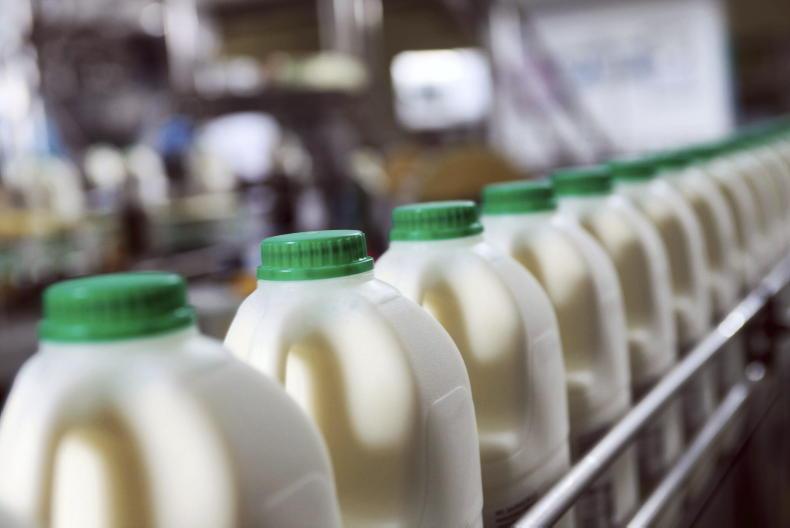November’s food price index (FPI) is just 0.2 of a point below October and given that there has just been a 1.9 point decline over the past four months, it is clear that we are in a relatively stable period for the international basket of food prices.
The index peaked in March at 159.7 points, which was the culmination of a period of rapid growth that began in the middle of 2021.
Of course, as the overall index is made up of a range of products, there will be movement within the categories.
From an Irish farming perspective, the areas of most interest are in the dairy, meat and cereals categories.
Dairy
The dairy index - at 137.5 in November - was down 1.7 points on the previous month and was the fifth monthly decline in a row.
Despite this, the index remains 11.6 points higher than it was this time last year. The ongoing fall is explained by cooling international demand for dairy commodities.

Dairy price index fell by 1.7 points in November.
The biggest fall was for skimmed milk powders caused by the combination of weaker markets and increased supply from Europe.
Whole milk prices were affected by lower demand from China, while butter demand eased, causing a fallback from recent record prices.
Cheese demand, on the other hand, was steady and supply was constrained by less exporting from EU producing countries.
Meat
The meat index, like dairy, also had its fifth month of decline in November, falling by 1.1 points, but it too remains ahead of where it was a year ago by 4.6 points.

Meat price index fell by 1.1 points in November.
Beef prices internationally were under pressure because of increased supplies from Australia and Brazil, though demand from China remained strong.
Strong demand for sheepmeat triggered an increase in price, while poultry prices were also strong on the back of supply concerns caused by avian flu in many countries.
Pig prices also experienced a surge driven by international demand, despite Chinese production having returned to pre-African swine fever levels.
Cereals
The cereal price index fell 1.9 points in November to 150.4, but as with meat and dairy, this remains ahead of the same time last year, in this case by 9 points.
Wheat prices fell 2.8% with the resumption of shipments from Ukraine and increased shipments from the Russian federation. This increased the supply side and created competition in international markets.
Maize prices were down by 1.7%, again influenced by the resumption of Ukrainian shipments, while barley prices increased by 2.8%.
Comment
The FPI is a barometer of global trends across different commodities traded at wholesale level. Prices were increasing rapidly this time last year, which fed into consumer price increases over recent months.
Having had a period of relative stability over the past four months, this suggests a levelling off of consumer prices unless events cause a further upsurge. The biggest threat comes from energy and fuel prices increasing further.
Read more
Global food commodity to hold steady for November
Input costs double in two years
November’s food price index (FPI) is just 0.2 of a point below October and given that there has just been a 1.9 point decline over the past four months, it is clear that we are in a relatively stable period for the international basket of food prices.
The index peaked in March at 159.7 points, which was the culmination of a period of rapid growth that began in the middle of 2021.
Of course, as the overall index is made up of a range of products, there will be movement within the categories.
From an Irish farming perspective, the areas of most interest are in the dairy, meat and cereals categories.
Dairy
The dairy index - at 137.5 in November - was down 1.7 points on the previous month and was the fifth monthly decline in a row.
Despite this, the index remains 11.6 points higher than it was this time last year. The ongoing fall is explained by cooling international demand for dairy commodities.

Dairy price index fell by 1.7 points in November.
The biggest fall was for skimmed milk powders caused by the combination of weaker markets and increased supply from Europe.
Whole milk prices were affected by lower demand from China, while butter demand eased, causing a fallback from recent record prices.
Cheese demand, on the other hand, was steady and supply was constrained by less exporting from EU producing countries.
Meat
The meat index, like dairy, also had its fifth month of decline in November, falling by 1.1 points, but it too remains ahead of where it was a year ago by 4.6 points.

Meat price index fell by 1.1 points in November.
Beef prices internationally were under pressure because of increased supplies from Australia and Brazil, though demand from China remained strong.
Strong demand for sheepmeat triggered an increase in price, while poultry prices were also strong on the back of supply concerns caused by avian flu in many countries.
Pig prices also experienced a surge driven by international demand, despite Chinese production having returned to pre-African swine fever levels.
Cereals
The cereal price index fell 1.9 points in November to 150.4, but as with meat and dairy, this remains ahead of the same time last year, in this case by 9 points.
Wheat prices fell 2.8% with the resumption of shipments from Ukraine and increased shipments from the Russian federation. This increased the supply side and created competition in international markets.
Maize prices were down by 1.7%, again influenced by the resumption of Ukrainian shipments, while barley prices increased by 2.8%.
Comment
The FPI is a barometer of global trends across different commodities traded at wholesale level. Prices were increasing rapidly this time last year, which fed into consumer price increases over recent months.
Having had a period of relative stability over the past four months, this suggests a levelling off of consumer prices unless events cause a further upsurge. The biggest threat comes from energy and fuel prices increasing further.
Read more
Global food commodity to hold steady for November
Input costs double in two years








 This is a subscriber-only article
This is a subscriber-only article










SHARING OPTIONS: